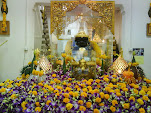
PRINCE SIDDHATTHA’S BIRTH
Queen Mahamaya, a wife of King Suddhodana of Kapilavatthu gave birth to prince Siddhattha, the Buddha-to-be, at Lumbini Park, on the Vishahka’s Full Noon Day (the sixth lunar month), 80 years before the Buddhist Era (623B.C)

ON ROYAL PARK VISIT
Prince Siddhattha (the Buddha-to-be) came across the Four Sights on his trip outside the palace: (1) an old man, (2) a sick man, (3) a dead man and (4) a wandering monk, which made him weary of conditioned things. Upon seeing these four sights, he was inspired to go forth in the Great Renunciation

THE GREAT RENUNCIATION
Returning from the last visit and learning that Yasodhara, his wife had given birth to a son named Rahula, the Prince, the 29 years old Prince cut off his hair with a sword and began an ascetic life in search of spiritual freedom from suffering

THE PRACTICE OF AUSTERITIES
The Bodhisatta, first approached some ascetics to learn their theories and practices, but was dissatisfied with them. He, then, tried by himself to discover the best way to liberation by practicing several austerities such as fasting and self mortification by with the group of Five Companions in attendance nearby.

THE MIDDLE WAY
The Bodhistta, having undergone for six years these austerities, realized that self-mortification is not the right way to enlightenment. He, then, gave it up and started the practice of Mental Development known as “the Noble Eight fold Path” or the Middle Way.

THE ENLIGHTENMENT
The Bodhisatta at the age of 35 through the Middle Way attained Enlightenment under the Bodhi Tree in Bodhagaya, India, at the dawn of the Visakha’s Full Moon Day. Thereafter, he became known as the Buddha, the Enlightened One or the Awakened One.

PREACHING THE FIRST SERMON
After two months, the First Sermon was delivered to the group of Five Ascetics at Isipatana, The Deer Park Varanasi. The principles of the Sermon were based on the Four Noble Truths: Suffering, It’s Causes, its Cessation and the Path leading to Cassation of suffering. This is known as “ The Turning of the Wheel of truth”.

THE GREAT LEADER OF 1,000 ASCETICS
At Uruvela, there were three renowned religious teachers known as “Matted Hair Ascetics”. The elder was called Kassapa having a following of 1,000 ascetics. After hearing the Buddha’s teachings, they all joined the order. When the Buddha met King Bimbisara of Rajagaha, the king and his royal retinue doubted his teachings. To eliminate their doubts, Ven Uruvela Kassapa declared himself “ the follower of the Buddha”.

THE HEART TEACHING OF THE BUDDHA
On the Magha’s Full Moon Day, nine months after his Enlightenment, the Buddha gave his most significant teachings known as “ Ovadapatimokkha”, (the Principle Teachings) to 1,250 Holy Noble Monks who assembled themselves without a prior appointment at Veluvanaram, Rajagaha.

THE GREAT COUPLE DISCIPLES
Sariputta and Moggallana, the two beloved friends of Rajagaha, along with their 250 followers approached the Buddha and asked for ordination. Later on, they both became the most well known chief disciples of the Buddha in propagating his teachings.

THE ALLOWANCE OF BIKKHUNI SANGHA
The Buddha allowed and accepted Queen Maha Pajapati, his aunt and step-mother into the Order of Bukkhuni (Buddhist nuns) along with her 500 Royal women the opportunity to experience the highest wisdom in life

THE LAST DISCIPLE
On his death bed at Kusinara, the Buddha, as his last gift, ordained Subhadda, the Wanderer, who came seeking spiritual guidance. He was the last monk who was ordained by the Buddha.

PASSING AWAY
Having preached to his last disciple, Subhadda, the Buddha passed away into Parinirvana (perfect Extinction) on the Visakha’s Full Moon Night at Salavanodayana. The Malla’s Garden one year before the Buddhist Era(543 B.C) at the age of 80. Parinirvana (Parinibbana) means “Utter or Final Nirvana” the ‘Total Letting Go’ at the moment of death of a Fully enlightened Being ( a Buddha or Arahant).


















